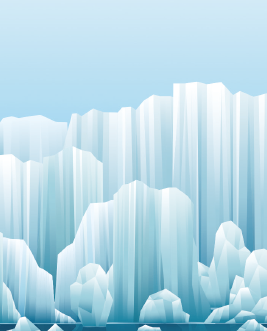How Glaciers Work
Glaciers are the largest moving objects on earth. They’re massive rivers of ice that form in areas where more snow falls each winter than melts each summer. Their scale is truly gargantuan! The glaciers of Antarctica are so heavy they actually change the shape of the planet. Furthermore, and perhaps most importantly, three quarters of the world’s total supply of freshwater is frozen in glaciers.
The force of glaciers carves out lakes, grinds down mountains and reduces solid rock to fine dust. Glacial meltwaters created the most spectacular floods in our planet’s history. Some glaciers dam rivers, creating lakes behind them. There’s a good chance that the landscape you live on today was shaped by glaciers thousands of years ago, during the so-called ice ages when glaciers covered three times as much area as they do now.
Today scientists look to glaciers as a measuring stick for global warming. Receding glaciers provide clear evidence of a warming Earth. If more glaciers began melting, there would be a huge rise in sea levels which would change the planet and human civilisation.
There are two types of places on Earth where glaciers form: at the north and south poles where it’s always really cold; and at high elevations, such as large mountain ranges. A glacier is basically an accumulation of snow that lasts for more than a year. In the first year, this pile of snow is called a névé. Once the snow stays around for more than one winter, it’s called a firn.
As more and more snow piles up over the years, the weight of the snow on top starts to compress the snow on the bottom. This compression turns the snow to ice. It’s just like taking a handful of fluffy snow and squeezing it into a hard snowball. The compression of the glacier continues for dozens, hundreds or even thousands of years, adding more and more layers on top and adding even more weight. The ice eventually gets compressed so much that most of the air is forced out of it. That is what causes glacial ice to appear blue.
Eventually, the glacier becomes so heavy that it starts to move. It isn’t like a solid block of ice tumbling down a hill. A glacier is a river of ice. It flows. That’s because the highly compressed layers of ice are very flexible. The upper layers, which aren’t under as much pressure, are more brittle. This is why it’s so dangerous to walk on a glacier – the upper layers fracture and form huge crevasses which sometimes get covered over by fresh snow.
Glaciers are so heavy that they dramatically change the shape of the land they rest on and move over. In fact, one of the biggest effects of any glacier on the planet requires no movement at all, just weight. The Antarctic ice cap is so heavy that it compresses the Earth at the South Pole. As a result, Earth is slightly pear-shaped, with the South Pole flatter than the North Pole.

